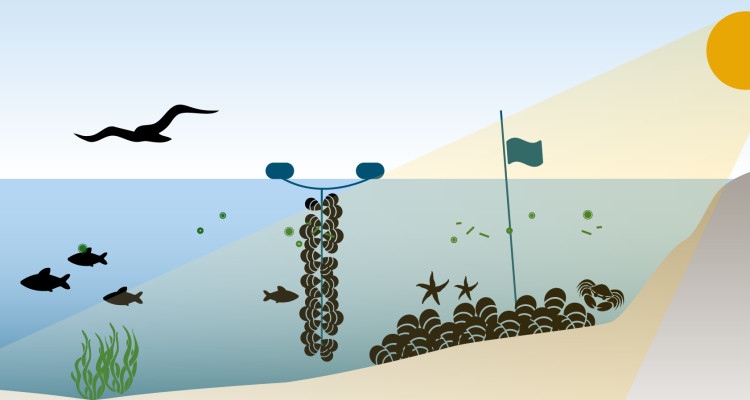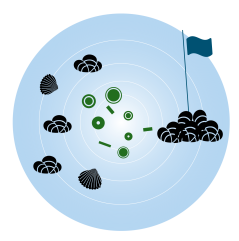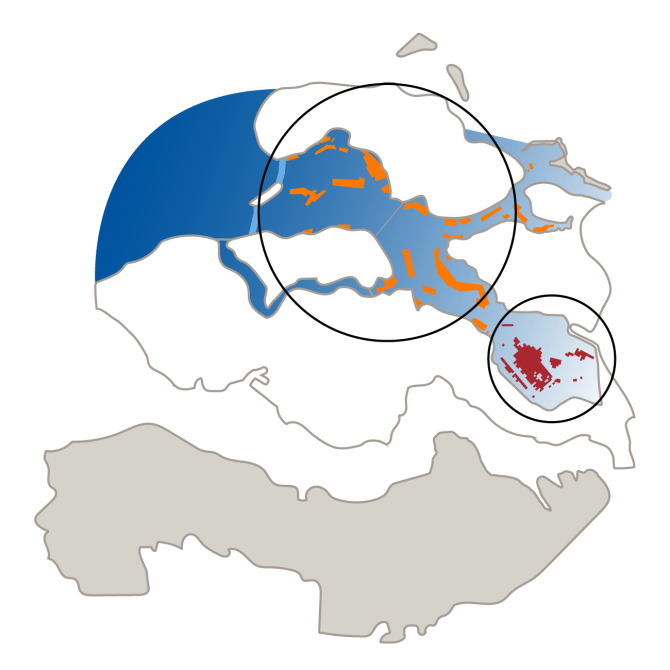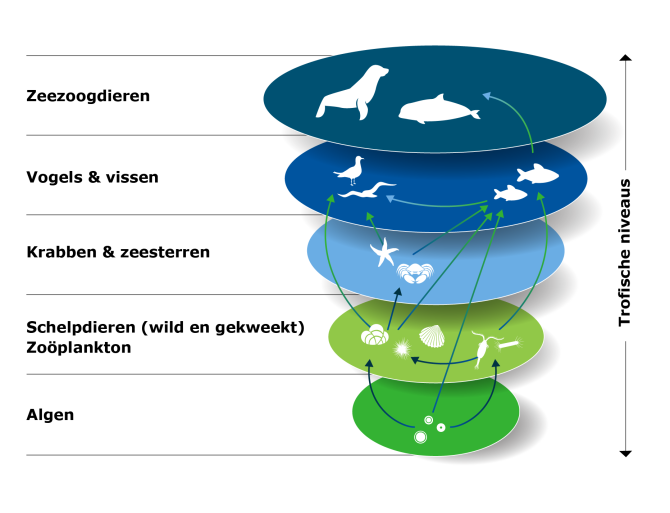
Carrying capacity for shellfish
About 50 million kilos of mussels and 30 million oysters are cultivated annually in the Netherlands. What is the carrying capacity of the Eastern Scheldt, Lake Grevelingen and the Wadden Sea for shellfish cultivation, given the natural populations of shellfish that occur there? Wageningen Marine Research is investigating this carrying capacity for an optimum balance between nature and food production.
What determines the carrying capacity for wild and farmed shellfish?

The carrying capacity of the ecosystem is mainly determined by the amount of food (microalgae) available to the shellfish. Here, cultivated stocks compete with naturally occurring shellfish, such as cockles, for the available food.
Microalgae use light from the sun as an energy source to convert CO2 into sugars, allowing them to grow and multiply. This growth is also called primary production. In winter (and when the water is very turbid) there is not enough light and primary production is low. Besides light, microalgae also need the nutrients nitrogen (nitrate and ammonium) and phosphate to be able to produce proteins. A group of algae (diatoms or calcareous algae) also require silicate for their calcium skeleton.
Microalgae grow mainly in spring. Then there are sufficient nutrients and sunlight. In the summer, the nutrients are depleted and primary production decreases (nutrient limitation). In addition to local primary production, microalgae can also be supplied by the tides from the North Sea.
Shellfish filter the microalgae out of the water using their gills. Once they have eaten the microalgae, they digest them. Nitrogen and phosphate are released back into the water in the form of ammonia (just as humans do in the form of urea). The released nutrients can be used again by the microalgae for primary production.
Shellfish farming

Mussel farming (orange)
In the Netherlands, approximately 50 million kilos of mussels are produced on the cultivation plots each year. The mussels spend about two years in the plots before they are harvested. In the Eastern Scheldt, the best cultivation plots are located near the storm surge barrier, where there is a lot of food supply from the North Sea.
Oyster culture (red)
The annual production of oysters in the Eastern Scheldt and Grevelingenmeer is approximately 30 million units. In the Eastern Scheldt, the oyster plots are located in the south-eastern part. There is less food in this area because most of the microalgae from the North Sea have already been grazed out by the mussels. Oyster farming in this area is therefore largely dependent on the local primary production of microalgae.
Food web
Microalgae are the basis of the food web, and are eaten by both wild and farmed shellfish and zooplankton (each other's competitors). The shellfish, in turn, are food for crabs, starfish, birds and fish. The more shellfish, the more biomass of the upper trophic levels can be supported. However, the food web relationships are complex, so that it is not always easy to translate the carrying capacity for shellfish into carrying capacity for birds or fish.

To understand the relationships properly, knowledge of the functioning of the ecosystem is important. Through intensive monitoring and the development of models that integrate knowledge and data, Wageningen Marine Research is working towards a better understanding of the functioning of the ecosystem and thus the carrying capacity for shellfish.
Publications
-
Draagkracht van de Oosterschelde en westelijke Waddenzee voor schelpdieren : evaluatie van veranderingen in de voedselcondities en schelpdierbestanden in relatie tot de mosselkweek in de periode 1990-2016
Yerseke: Wageningen Marine Research (Wageningen Marine Research rapport C096/19) -
Meten van primaire productie in de Oosterschelde, Grevelingenmeer en het Veerse Meer : Overzicht van methodieken en plan van aanpak voor monitoring
Yerseke: Wageningen Marine Research (Wageningen Marine Research rapport C022/19) -
Feedbacks from Filter Feeders: Review on the Role of Mussels in Cycling and Storage of Nutrients in Oligo- Meso- and Eutrophic Cultivation Areas
In: Goods and Services of Marine Bivalves - Springer - ISBN: 9783319967752 - p. 143-177. -
Bivalve Aquaculture Carrying Capacity : Concepts and Assessment Tools
In: Goods and Services of Marine Bivalves - Springer - ISBN: 9783319967752 - p. 451-483. -
Monitoring draagkracht voor schelpdieren in relatie tot opschaling MZIs in de Waddenzee en Oosterschelde
Den Helder: Wageningen Marine Research (Wageningen Marine Research rapport C043/18) -
Draagkracht voor schelpdieren : definities, indices en case studie
Yerseke: Wageningen Marine Research (Wageningen Marine Research rapport C023/17) -
Decrease of the carrying capacity of the Oosterschelde estuary (SW Delta, NL) for bivalve filter feeders due to overgrazing?
Aquaculture (2013), Volume: 404-405 - ISSN 0044-8486 - p. 28-34.